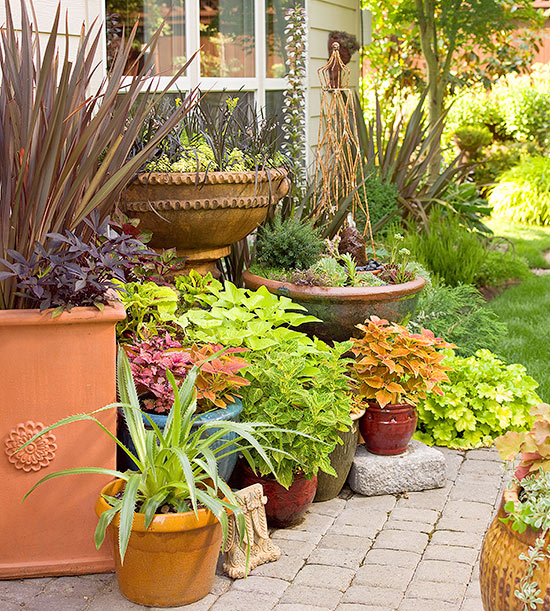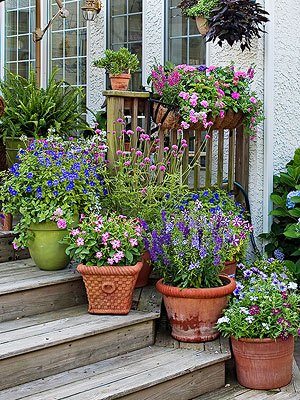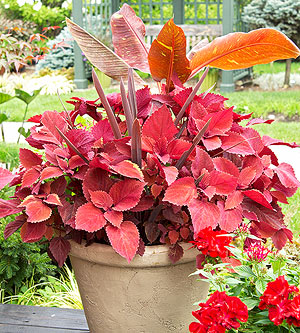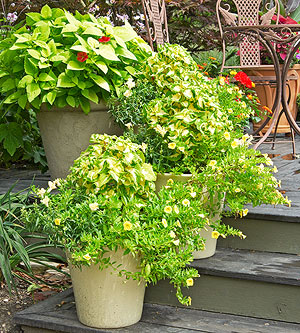
Group Containers for Flexibility

Artfully arranged container gardens soften hardscapes and add living beauty that’s easily changed through the seasons. Pots are portable and flexible, and a garden composed of containers naturally evolves through the growing season as plants peak and ebb. Enhance the drama by shifting pots around as the plants grow. Shortly after planting, cluster containers closely to create a sense of fullness. As plants mature and fill in, spread pots apart.
Introduce more play into a container garden by moving plants in peak bloom to the forefront of the garden or elevating them above their neighbors. Likewise, slip plants past their prime to less prominent positions.
continue reading below
Pairing Impossible Partners
Containers can play matchmaker for plants that can’t intermingle in the garden because of differences in height. Slip short plants into pots and elevate them to heights beyond their reach to create surprising, unexpected quick-color combinations.
For instance, a burgundy Cordyline, which typically grows 4-5 feet in a single season, looks stunning beside a ‘Vancouver Centennial’ geranium with chartreuse leaves splashed with brick red. The geranium grows only 12-18 inches tall, but by elevating its pot a mere 6 inches, the Cordyline and geranium pairing shifts into eye-pleasing scale.
Other plants assisted with height include a tall dahlia with a short coleus (match the dominant shade of the coleus leaves to the color of the dahlia bloom) and tall purple ornamental millet with short annual phlox.
Give Plants a Boost

When using multiple containers, position pots at varying heights for a more natural-looking scene with height and vertical interest. Follow these tips when lifting pots:
Elevate small pots or plants to eye level to embody them with star power. Instead of being lost as ground-hugging squatters, they are lifted into scale with the surrounding scenery, commanding attention.
Showcase easily overlooked blossoms by raising plants as they come into bloom. You also can shine a spotlight on artful objects, such as a saucer-style birdbath or tabletop fountain, simply by changing their height.
Invert pots or saucers, 5-gallon buckets, bricks, concrete blocks, or logs cut to length to add height. Build your own pot elevators with treated lumber, or rely on pot feet or manufactured plant stands. Any object serving as a plant hoist must be sturdy. A well-watered container is heavy enough to crush a flimsy stand. Plant supports also need a wide base to stand up to wind.
Camouflage container elevators by placing shorter pots full of rounded mound-shape plants such as Lantana, Pentas, Melampodium, Profusion zinnia, or geranium in front of the elevators. To screen taller plant lifts, position misty-shape plants like Diamond Frost Euphorbia or Mexican feathergrass in front of the supporting objects.
Same Colors, Different Plants
Present a cohesive container-garden display by filling separate pots with plants that echo one another’s colors. Repeating hues and shades gives you freedom to create distinctive container gardens that still relate to one another. Gather these containers into a display, and you have a garden masterpiece.
Seeing Red

A trio of foliage plants — Redhead coleus, ‘Red Star’ Cordyline, and ‘Siam Ruby’ banana — serve varying shades of red that sparkle when teamed with a container filled with red geraniums and rose Nicotiana.
Cheery Yellow

Plant two pots identically to create a goof-proof container blend. The yellow plants shown here are ‘Versa Green Halo’ coleus, Twinny snapdragon, and Superbells Yellow Calibrachoa.
SOURCE:http://www.bhg.com/gardening/container/plans-ideas/how-to-group-container-gardens-together/